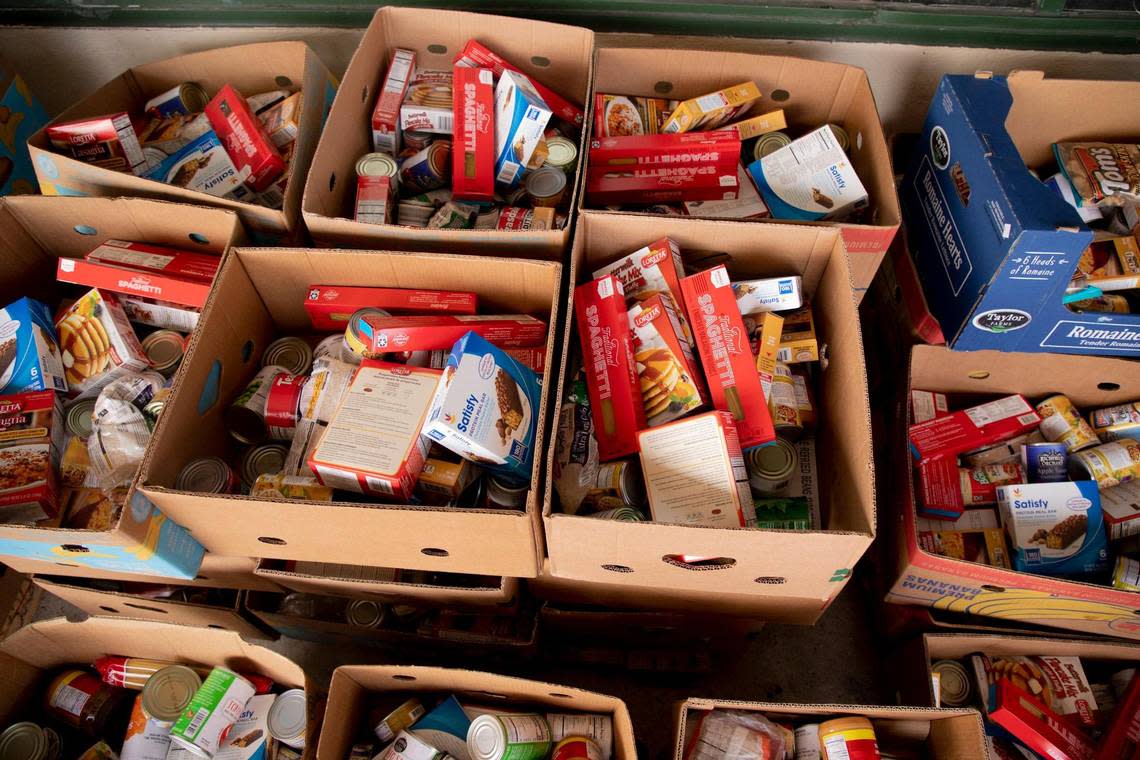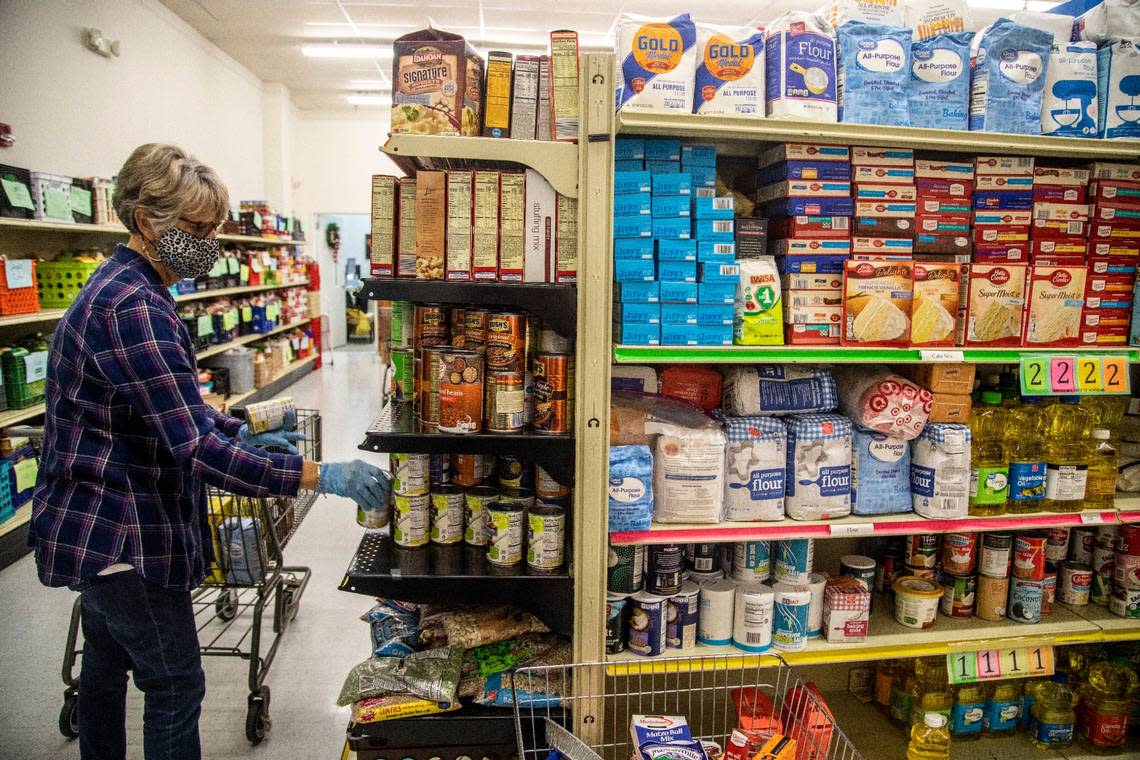Food Pantry 101: How to get free food from a food pantry (and how to donate)
Higher grocery costs are sending more families to food banks and food pantries, which are working hard to meet those needs.
“Food is getting more and more expensive, and if you need to — or better yet, if you want to — use a food pantry, do it,” said Maggie Kane, founder and executive director of A Place at the Table, a pay-what-you-can cafe in Raleigh.
Here’s everything you need to know about how to get free supplies from a food pantry, and how to best serve the food pantries in your area by donating food, money or your own time.
Debunking 7 food pantry myths
Myth #1: You have to be in a certain income bracket to use a food pantry.
Fact: The vast majority of food pantries don’t ask for income verification, so anyone who needs food that day can get it. Many food pantries, however, have residency requirements to use their resources.
If you’re going to a food pantry for the very first time, it’s smart to bring proof of residency — like a driver’s license or utility bill. If you’re ineligible to receive food from that pantry, volunteers and staff members will make sure you know which food pantries you’re able to visit.
Myth #2: Holidays are food pantries’ largest distribution days.
Fact: Most food pantries are actually closed on holidays.
Staff members and volunteers spend the day celebrating with loved ones, and food needs to be distributed ahead of time so people can plan their meals.
“We use frozen turkeys, and those need time to thaw. We can’t give them out Thanksgiving morning and expect people to have them on the table a few hours later,” said Pat Haggard, executive director of the Holly Springs Food Cupboard.
Myth #3: Food banks and food pantries are the same thing.
Fact: They work in conjunction with one another, but food banks differ from food pantries.
Food banks supply food to food pantries and other partner agencies, like crisis shelters and soup kitchens. Food banks often partner with major grocery stores and farmers, collecting both fresh and non-perishable foods. If you’ve ever been a part of a school or church food drive, those items typically go to food banks.
Food pantries take food from food banks and distribute it to people and families in need. While food pantries can be standalone organizations, they’re often part of a larger group, like a shelter or a church.
Myth #4: You can only get canned and nonperishable foods from a food pantry.
Fact: Many food pantries give recipients a combination of fresh foods — like milk, eggs, produce and meat — and nonperishable foods — like pasta, canned vegetables and rice.
Monetary donations and partnerships with food banks can help make fresh food possible.
Some smaller food pantries only give out canned and other nonperishable foods, but that’s not the case for all food pantries. Most in the Triangle give out fresh food too.
Myth #5: Food pantries accept all food donations.
Fact: Food pantries typically try to accept whatever is donated to them, though there could be space or perishability limitations.
A small-scale food pantry that is run out of a closet likely can’t accept gallons of milk or tubs of ice cream. Even a larger food pantry might not have the space to accept hundreds of pounds of canned goods.
Many food pantries have different partnerships throughout the year. They may work with a specific elementary school in the fall, for example, and a women’s shelter in the winter, and these groups need different items.
If you’re making a grocery store run hoping to pick up some food items to donate, check in with the food pantry ahead of time to see what they really need right now. Some food pantries keep these lists updated on their websites and social media pages.
Myth #6: Food pantries accept donations at any time.
Fact: Food donations are often confined to specific days and hours of the week, as many food pantries are volunteer-operated and not constantly staffed. Be sure to check website hours or calling ahead before heading over for a drop off.
Monetary donations, however, can be made online at any time.
“Although we appreciate all food donations, the buying power afforded food pantries by buying in bulk really makes cash donations more valuable than food donations,” said Barlkey Sample, regional director of the Catholic Charities of the Diocese of Raleigh. “We can buy any item less expensively than it costs the public to buy it and donate to us.”
Myth #7: Food pantries are open 24/7.
Fact: Most food pantries are only open a few hours a week, and they sometimes have one weekly (or even monthly) distribution day. It’s important to check websites and/or social media pages to make sure you show up at the right time.
If you need food, get there early. Food pantries will close when supplies run out.
“Sometimes people start lining up at 7 a.m., when our pantry doesn’t open ‘til 9,” said Nick Robertson, Urban Ministries of Wake County’s director of hunger and nutrition.

How to get food from a food pantry
Step 1: Identify the food pantries in your area.
You can check in with your place of worship or nearby schools, or you can use The Food Bank of Central & Eastern North Carolina’s Food Finder website tool to find pantries in or near your zip code: foodbankcenc.org/food-finder.
Step 2: Check out the pantry’s website.
Here, you can learn when the pantry operates, what kind of food they distribute and if you need to sign up ahead of time to receive their services.
Make sure you check out eligibility requirements and double check that this pantry can serve you.
Step 3: Visit the pantry on its distribution day.
Websites and social media pages will have this information. Pantries are typically only open a few hours a week, and distribution days can often be once a week or once a month.
Step 4: Follow instructions to get food.
You’ll either stay in your car and have food brought out to you, or you’ll park and go inside to “shop” (meaning you can decide what food you want to bring home, but you won’t pay for items like you would in a grocery store).
You can typically find out which model the food pantry uses ahead of time by visiting their website. When you arrive, food pantries will normally have signs for drive-through traffic and/or parking.
Step 5: Find out when you’re able to come back.
Different food pantries have different requirements.
Hope Community Church in Raleigh, for example, has families come back for more food and supplies every 30 days, while Urban Ministries of Wake County lets families come once a week.

How to help a food bank or food pantry
Find out if there’s a list of needed items, and stick to it.
Food pantries might be gearing up for a specific event (like a back-to-school distribution event) or serve a specific group of people (like women, college students or infants).
Before buying groceries to drop off at the pantry, check websites or call the organization to see if they have any specific needs.
Drop off items at the correct spot on the correct day.
Smaller food pantries might have very little storage space, so perishable items (like dairy or meat) might need to be dropped off in a very specific window of time.
“Most people think they can do their Thanksgiving shopping on Wednesday night and swing by the pantry Thursday morning to help with our distribution. We’re not open on Thanksgiving, and give out the food days before the holiday,” Haggard said.
“If you want to help, make sure you know when we’re open and where you can bring the food, especially if it’s perishable.”
Host a food drive in your neighborhood, place of worship or family gathering.
Food drives contribute to a large bulk of donations. Get in touch with your local food pantry (or food bank), find out if there are specific items needed and ask attendees to stick to the list.
Sign up for a volunteer shift.
“You don’t have to be a church member, or a regular recipient of a nonprofit’s services, to help out,” said Rev. Rob Phillips, White Plains United Methodist Church of Cary’s pastor of invitation and engagement.
“When people come to help us sort and distribute food, it allows our church to be focused on our mission to make God’s love real to the community, which includes people helping as well as receiving.”
When in doubt, donate cash.
Cash donations can be more beneficial than food donations.
Almost all food bank and food pantry websites have an easy-to-find “Donate!” button on their websites. With internet connection, you can donate anywhere and at any time.
“Our grocery bill was $1500 just last week. A year or two ago, it was looking like $300,” Haggard said. “We’ll never turn down a monetary donation. Since we need to buy so much, that’s really helpful.”
